Decoding Intellectual Property: A Legal Expert's Guide to Understanding IP Rights
30 Jan 2023
28 May 2020
min read
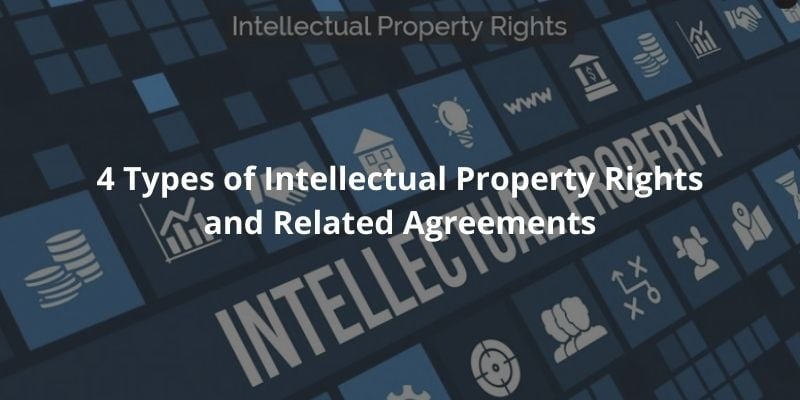
As a business owner, protecting your Intellectual Property ("IP") rights and ideas should be one of your foremost concerns. Intellectual Property protection is crucial as it enables you to prevent others from using your original ideas and profiting off them. There are, however, several considerations that protecting your IP rights requires, including registration, licensing, and infringements. If you are unsure as to what you need to do, don’t worry - we have created a guide (prepared by an Intellectual Property Lawyer!) on how you can protect the four main types of IP rights: trademarks, copyrights, patents, and trade secrets. We’ve also included sample intellectual property agreements and documents for you to use.
A. What is Intellectual Property?
1. What does IP stands for? What does IP mean?
IP stands for Intellectual Property. Intellectual property is a category of property that constitutes intangible property rights created through human intellect. It includes inventions and designs (patents); literary and artistic works (copyright); and symbols, names, and images used in commerce (trademark). It also includes other types of rights, such as trade secrets, publicity rights, moral rights, and rights against unfair competition.
2. Why is intellectual property protection important to my business?
IP is extremely important to every business as it permeates every aspect of our daily lives. It pertains to brand logos on clothes, newspaper articles, TV shows, popular songs, movies, movies, fashion design, etc. The list goes on.
Intellectual property rights protection is crucial because protecting it helps protect creativity. The main purpose of IP law, therefore, is to encourage the creation of a large variety of intellectual goods. The efforts of writers, artists, designers, software programmers, inventors, and other talents need to be protected so there is an environment where creativity can flourish and hard work can stand out and be rewarded.
To achieve this, IP law works to give business owners a personal right to exclude others from stealing or using intangible assets of their business for a specified duration. By obtaining an IP right, you are also able to exclude others from selling, copying, or using the protected property without permission. This helps retain an incentive for you to create new things because it allows you to profit from the information and intellectual goods you create.
Even if you are not a creator of intellectual property, IP law and the protection of intellectual property are still relevant. As the other party, you should be aware of the protections and restrictions placed by IP law such that you do not inadvertently infringe other people's intellectual property rights.
3. What are the types of Intellectual Property rights that can be protected?
Not all ideas, inventions, or creations are/can be protected.
For example, to balance the interests of intellectual property owners and society, pharmaceutical inventions are often protected through patent registration, while things like special treatments for diseases are not protected. It is also illegal to add famous cartoon characters to commercial products without permission.
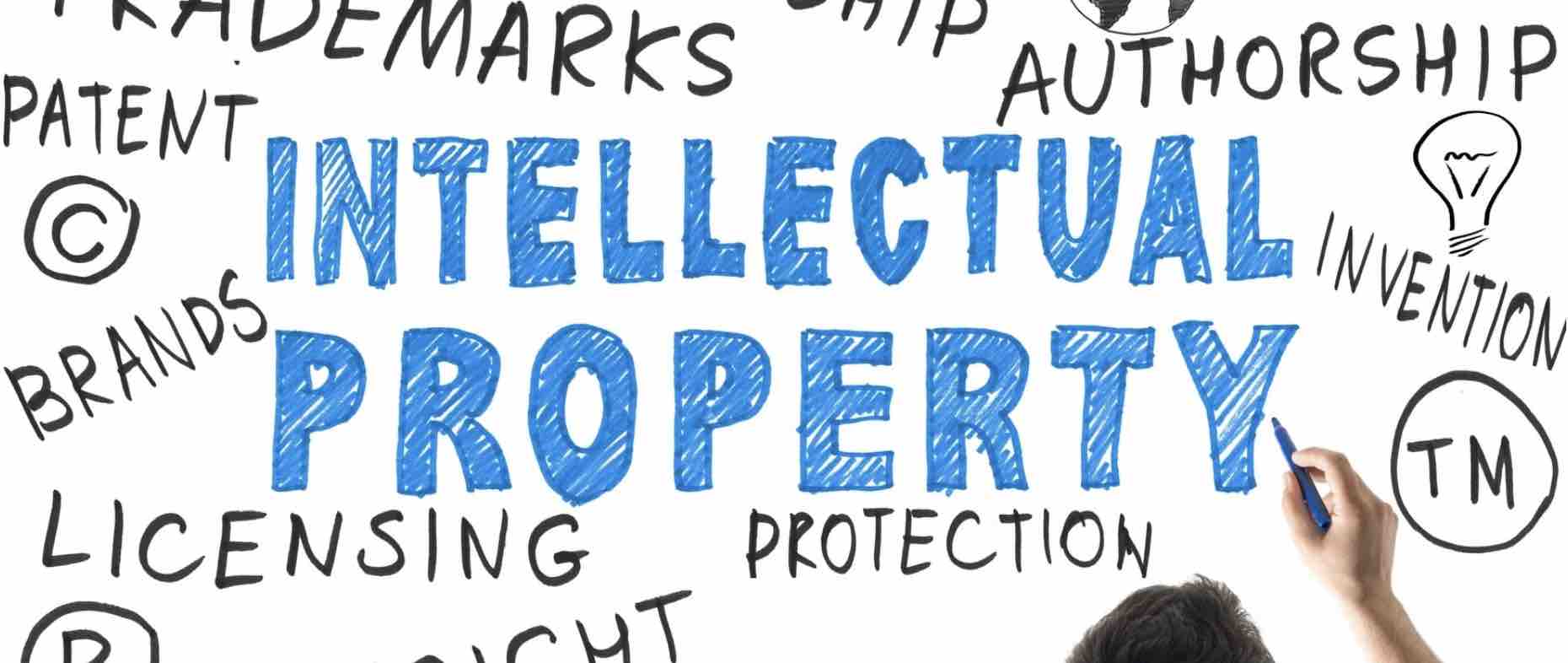
B. Managing Intellectual Property
1. What are the 4 types of Intellectual Property?
The 4 types of Intellectual Property rights include trademark, copyright, patent, and trade secret. Let’s explore them in more detail:
(A) Trademark protects the image and reputation of the trademark owner. This is most common for businesses that place a logo or signature characteristic on their product.
(B) Copyright protects authorial work (e.g. artwork) and derivative work (e.g. broadcast). This is commonly obtained by businesses that create documents (e.g. DocPro), artworks, or movies.
(C) Patent (including Design Patent) protects inventions and industrial property. Patents are mostly obtained by technology-driven and R&D-focused companies.
(D) Trade Secret also protects industrial property, but it offers more secrecy compared to patents. A trade secret is referred to as ‘confidential information' in some jurisdictions.
| Trademark | Patent / Design | Copyright | Trade Secret | |
| Subject Matter Normally Protected | Signs that distinguish the goods or services of one trader from those of others | Inventions, industrial products, designs, fabric designs | Books, software, plays, music, paintings, sculpture, photographs, films, sound recordings, broadcasts, cable programs, performances | Formula, practice, process, design, instrument, pattern, commercial method, or compilation of information not generally known or reasonably ascertainable. |
| Whether Registration is required for effective protection | Yes | Yes | No | No |
2. How do I protect the 4 types of Intellectual Property?
This guide on intellectual property law is directed at startups and small businesses and addresses questions that often arise when considering IP law protection within that context. With that in mind, this section will be divided into four sections for simplicity’s sake: (A) Trademark, (B) Copyright, (C) Patent, and (D) Trade secret.
Trademark and patent require registrations with the local intellectual property authorities for the protection to be effective. Copyright subsists in works without registration, and a confidentiality agreement is generally required to protect trade secrets. Please refer to the sections below for brief descriptions of each type of IP right and answers to common issues that arise for SMEs and start-ups regarding IP issues.
C. Trademark
1. What is a trademark?
A trademark is a recognizable sign, design, or expression which identifies the product or service of a particular source from those of others. It can be words, indications, decisions, letters, characters, numbers, colours, sounds, smells, or shapes, located on a package, a label, a voucher, or on the product itself.
A trademark is often used by a company to distinguish itself from competitors and is often displayed on company buildings.
2. Does a trademark need to be registered?
By trademarking a feature, one can stop competitors from using a similar logo or design.
Trademarks can be either registered or unregistered. The owner of a registered trademark has the exclusive right to use the mark on the goods and/or the services for which the mark was registered.
Unregistered trademarks may still be protected by the common law action of passing off. Passing off claims requires proof of the misrepresentation made, and is usually more difficult an action to bring than that for infringement of a registered trademark.
3. Can I trademark a name?
In general, you can trademark a name as long as the name is used for commercial purposes. Celebrities such as Benedict Cumberbatch and Amy Winehouse have famously registered their name as trademarks because the recognition surrounding their names is a fundamental part of their business presence and success.
However, a name cannot be registered if it is likely to be confused with other registered trademarks. For instance, the name ‘Benedict Cucumber’ may be rejected as a trademark as it is too similar to the existing trademark of ‘Benedict Cumberbatch’.
4. Should I register my trademark?
Registered trademarks are protected by law while unregistered trademarks are protected by common law. The rule of thumb is that in general, statutory law offers greater protection over IP rights. This means that if you are seeking a higher level of protection, you should register your trademark.
Another factor to consider while deciding whether you want to register your logo is the nature of your name and the stage of your business. Trademark registration can be expensive and time-consuming if you are filing in multiple countries (in particular if there is an objection and you are required to file an appeal). You should ensure that it is a trademark that you plan to keep in the long run before you start the trademark registration process.
5. Personal name for business purposes
You may not be able to register personal names you plan to use for commercial purposes personal names are often considered to be overly ‘descriptive’. It is, therefore, best to register your name as a trademark once it has developed a ‘secondary meaning’.
Secondary meaning means the name is so prominent that when people hear it they automatically associate the name with the goods or services you provide. For instance, Christian Dior or Louis Vuitton are personal names that have developed a secondary meaning.
Moreover, you own the trademark as soon as a name or a logo is used for business purposes. But to protect the trademark, one requires trademark registrations. By registering the trademark you can then enforce your exclusive right and exclude others from using a similar name or logo.
6. Other non-personal names
Trademark registration is essential for companies that plan to expand their business in new markets. Even for a small business with no intention of expanding into new markets, it is better to have its trademark registered as a form of protection against potential future claims by other companies of trademark infringements.

7. How to register a trademark:
There are four key steps to register a trademark: (i) identify the countries/jurisdictions for registration, (ii) ensure the trademark is registrable, (iii) ensure there is no previously similar trademark, and (iv) actual registration:
(i) Identify the countries/jurisdictions for the registration of a trademark
It is strongly recommended you register your trademark only in the jurisdictions of use. Worldwide registration is an expensive process, so you should identify jurisdictions of use and only register where necessary.
Each jurisdiction's trademark registration system is unique and separate from other trademark systems. As such, to obtain recognition for protection as registered trademarks in a jurisdiction, trademarks must be registered in each jurisdiction of use.
Under the Paris Convention, applicants for trademarks in a Convention jurisdiction can enjoy a right of priority concerning their corresponding applications in a Paris Convention country or WTO member.
Also note that if the owner is in a jurisdiction that is a party to the Madrid Protocol, one can go through the Madrid system to obtain a bundle of trademark registrations in separate jurisdictions. Registration through the Madrid System does not create a unified registration; rather, it creates a bundle of national rights through an international registration able to be administered centrally.
(ii) Ensuring the trademark is registrable
To register a trademark, one needs to ensure that the trademark is distinctive and graphically representable. But what does this mean?
The trademark cannot be generic or descriptive (i.e. describing its intended purpose function). For instance, one cannot trademark ‘SOAP’ or ‘cleaning soap’ for a soap product. The graphical representation also needs to be clear and precise.
An example of a successful trademark is Playdough. Hasbro trademarked the smell of playdough using the description of ‘sweet, slightly musky, vanilla fragrance, with slight overtones of cherry, combined with the smell of a salted, wheat-based dough.’
In certain jurisdictions, you will have to provide proof of use in that jurisdiction (e.g. the U.S.). In other countries, it is just on a first-come, first-serve basis, regardless of whether you are using it in the jurisdiction (e.g. China).
(iii) Ensuring there is no similar trademark
To avoid a potential trademark infringement lawsuit, it is important to check if another previously registered trademark is similar/identical to your design and is currently used in similar/identical businesses.
There are 45 trademark classes under the International Classification of Goods and Services for the Purposes of the Registration of Marks established by the Nice Agreement (the "Nice Classification”).
You should check that there is no similar mark within the same class you would like to register for. You can check out the classes under the Nice Classification here.
You can also conduct an initial search in one of the most important and comprehensive databases via WIPO.
Alternatively, you can try consulting your local Intellectual Property Department for a trademark registration record. Below is a directory of Trademark Registry in some of the most popular common law jurisdictions:
| Country |
Web Links |
|
Australia |
https://www.ipaustralia.gov.au/trade-marks |
|
Canada |
https://www.ic.gc.ca/eic/site/cipointernet-internetopic.nsf/eng/h_wr00002.html |
|
United States |
|
|
United Kingdom |
|
|
Hong Kong |
https://esearch.ipd.gov.hk/nis-pos-view/ |
|
India |
https://ipindiaonline.gov.in/eregister/eregister.aspx |
|
South Korea |
http://engdtj.kipris.or.kr/engdtj/searchLogina.do?method=loginTM |
|
Singapore |
https://www.ip2.sg/RPS/WP/CM/SearchAdvanceP.aspx |
|
Japan |
https://www.jpo.go.jp/e/support/j_platpat/trademark_search.html |
|
New Zealand |
https://www.iponz.govt.nz/about-ip/trade-marks/ |
|
Pakistan |
http://www.ipo.gov.pk/trademark_registry |
|
South Africa |
http://www.cipc.co.za/index.php/trade-marks-patents-designs-copyright/trade-marks/ |
(iv) Actual registration
-
Domestically: the precise registration procedure varies between countries, but it is common to register one’s trademark in the Trademark Registry under the Intellectual Property Department of their respective country.
-
Internationally - It is useful for large-scale businesses to register their trademark internationally. The international trademark system is known as the Madrid Protocol. Administered by the World Intellectual Property Organization (WIPO), the Madrid system allows you to protect your trademark in several countries by applying directly under a member country. For instance, HK is a member of the WIPO, meaning that you can register your trademark in Hong Kong before registering in other designated countries via the Madrid system.
For more information and a more detailed trademark registration guide, please look at our other entry on trademark registration.
8. How long does a trademark last?
Trademarks last for 10 years and can be renewed every 10 years. There is no limitation as to how many times a trademark can be renewed and as such a trademark right can potentially last indefinitely.
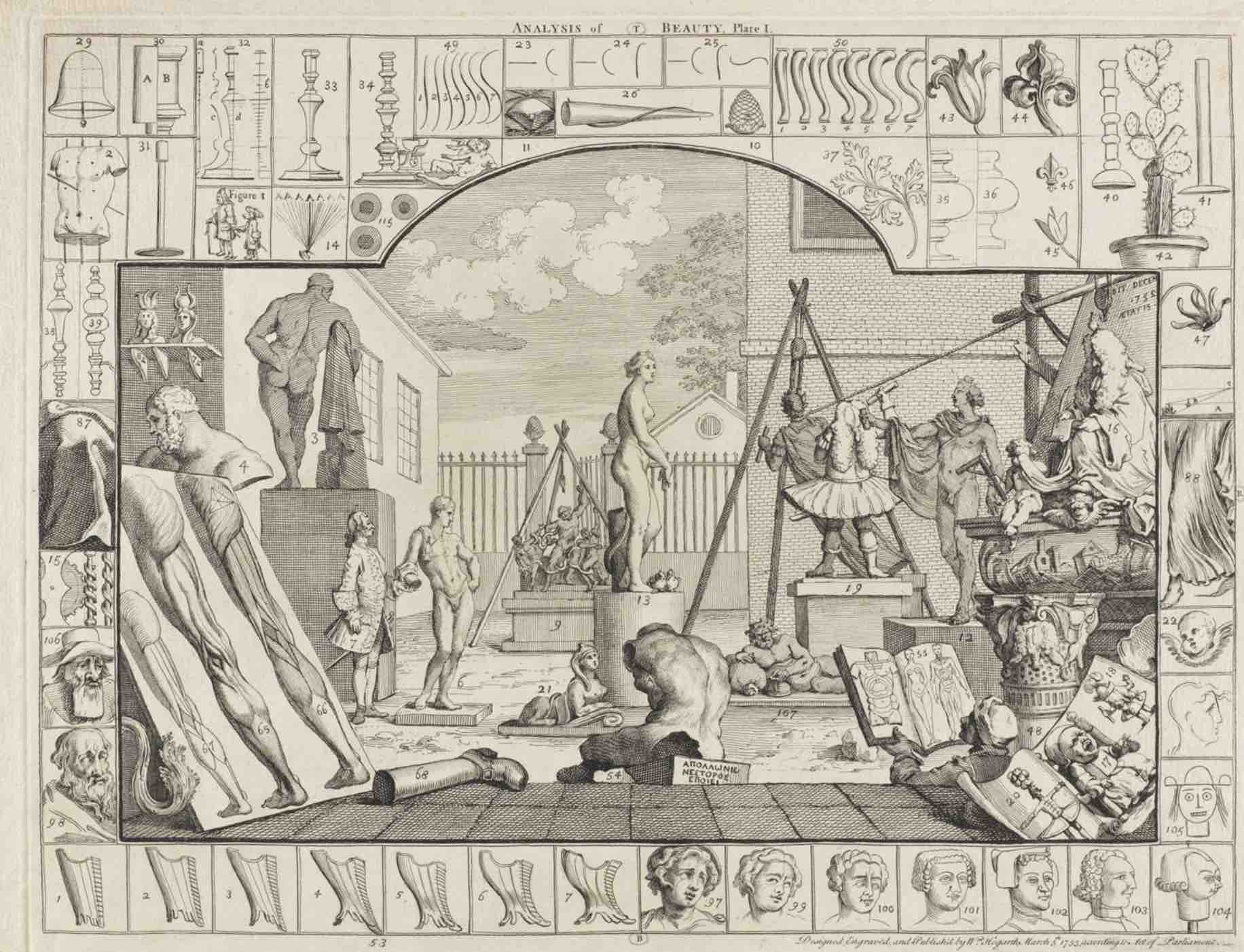
D. Copyright
1. What is copyright?
Copyright is a legal right that grants the creator of an original work exclusive rights to determine whether, and under what conditions, this original work may be used by others. Creators can also stipulate how long they want this right to last.
Copyright subsists in a work that is original and is recorded in writing, literary, dramatic, musical, and artistic works, as well as for sound recordings, films, broadcasts and cable programs, and works that are made available to the public on the Internet.
2. What exclusive rights are given to copyright owners?
Copyright laws give copyright owners certain exclusive rights to:
-
reproduce the work
-
prepare derivative works based on the work
-
distribute copies of the work to the public by sale or other transfer of ownership, or by rental, lease, or lending
-
perform and display the work publicly copying the work; e.g. through the Internet; performing, showing, and playing the work in public; and
-
broadcast the work or include the work in a program.
How long does Copyright last?
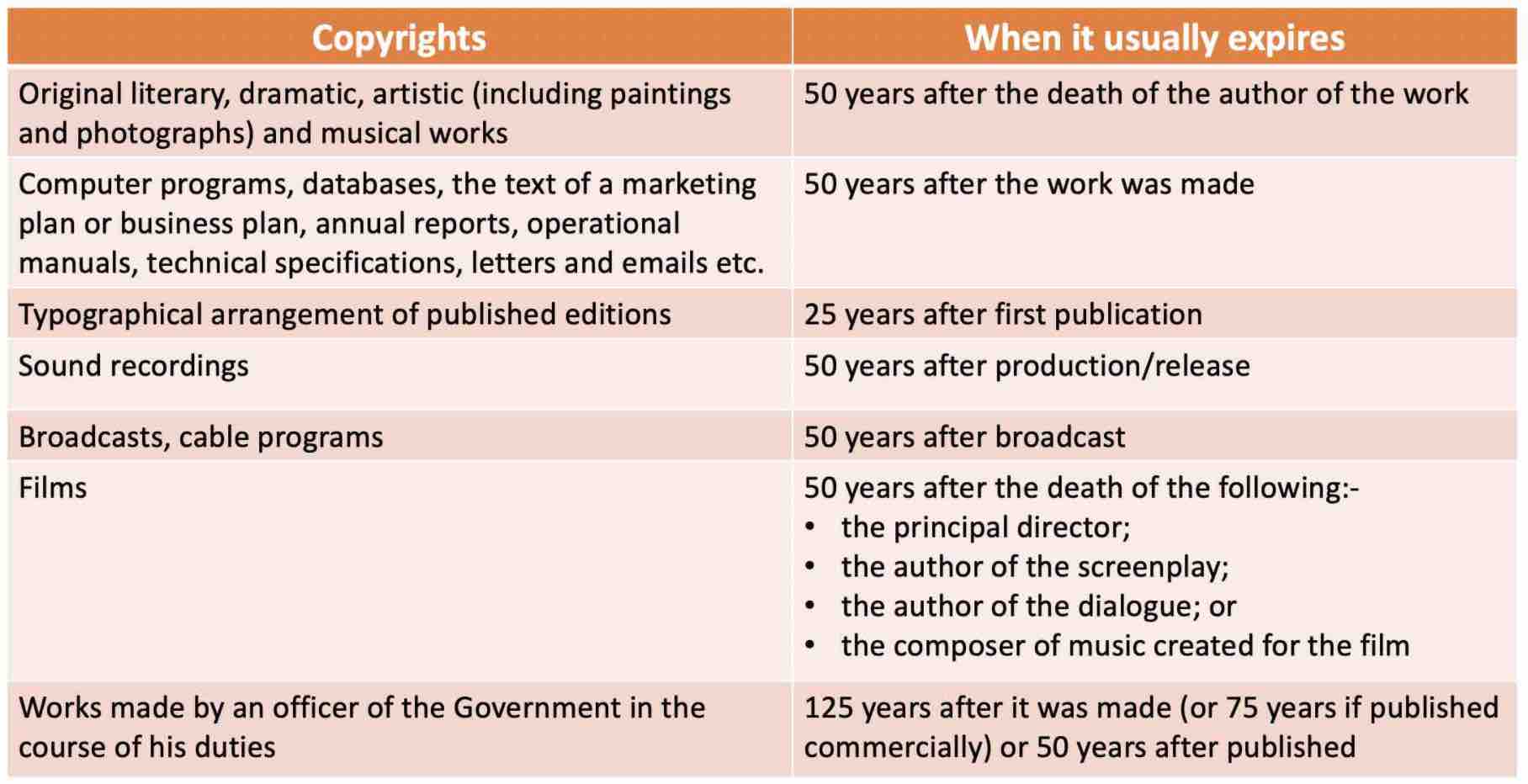
3. What does 'all rights reserved' mean?
All rights reserved (normally accompanied by the logo ©) is an indication of the creator reserving all IP rights provided by the law. By serving a copyright notice, the infringer is prevented from claiming to be innocent (i.e. do not know the work is copyrighted) and avoiding liability. According to copyright laws, one should only use another’s work with the permission of the copyright owner.
Note that there are four exemptions for copyright: fair dealing, incidental inclusion, persons with a disability, and education. If your action falls into one of the exemptions, then one can use the copyrighted work without any permission.
4. What is fair dealing?
Fair dealing means copying work for a permitted purpose. The usage of the work should be fair and must not prejudice the interest of the copyright owner. If the dealing involves copying an excessive part of a work, it is not likely to be regarded as fair dealing and a copyright notice is likely to be served.
Whether a dealing can be regarded as 'fair dealings' depends on various factors including the nature of the work, the proportion of the work used, and the effect of the usage of such work on the potential market.
5. Can I freely use the work available to the public?
‘Works in the public domain’ includes works with an expired copyright period (copyright expires 50 years after the death of the creator) or works that failed to meet the requirement for copyright protection. These works can be freely used without the worry of copyright infringement.
However, a freely available work (e.g. artwork available on the internet) is not necessarily 'work in the public domain'. A freely available work only means that the public is given free access to the work, but not the right to copy or issue copies of the freely available work.
6. Can I copyright a logo?
Yes, you can provide copyright protection for a logo.
The potentiality for copyright arises when a logo is created. However, the question lies in why you are seeking protection over your logo. For instance, If you want to obtain IP rights protection over your logo because you do not want other competitors to use a similar design and cause consumer confusion, it would be more appropriate to trademark the logo rather than copyright it (see the Trademark section).
However, if you want to protect your logo because it is an original artwork, you might wish to copyright your logo.
7. Do I need to register my copyrights?
In most common law jurisdictions there is no need to register a copyright. For instance, in Hong Kong and Singapore, as long as the work is original and recorded in a material form, copyright automatically arises without requirements for registration or other formalities. However, in countries such as the US or Canada, copyright requires registrations.
-min.jpg)
E. Patents
1. What is a patent?
Patents protect inventions. By obtaining a patent, one will obtain an exclusionary right to exclude others from making, using, selling, and importing an invention for a limited period.
In addition to patents for invention, you can also obtain design patents for legal protection granted to the ornamental design of a functional item.
2. What is patentable?
To be patentable, it must constitute a new invention that involves an inventive step and is susceptible to an industrial application (it also cannot belong to the excluded classes of inventions). The patent system encourages the development of new technology by granting a patent for an invention. In exchange, the patent holder is required to make full disclosure of the invention.
3. Can I apply for a worldwide patent?
Like the other types of intellectual property rights, patent protection granted in the jurisdiction is territorial. In other words, patents granted in one jurisdiction can only be enforceable in that jurisdiction. Patent systems are unique to each respective jurisdiction, meaning that patents granted in one jurisdiction do not guarantee protection in another jurisdiction.
4. How do I patent an invention?
To obtain a patent, your invention must be susceptible to industrial application, new (i.e. never disclosed to the public), and involve an inventive step to be successfully registered.
A patent requires the applicant to disclose the description and process of its invention. By obtaining a patent right, you can also gain profit by leveraging your patent portfolio and licensing your patent. The downside is that you will have to disclose details of your invention to the public.
In many jurisdictions, there are two types of patents granted, namely standard patents and short-term patents (because of the time it takes to grant a standard patent):
-
Standard Patents: an application for a standard patent in most jurisdictions is a two-stage application - (i) a request to record within 6 months after the date of publication of the corresponding patent application in one of the designated patent offices, and (ii) a request for registration and grant within 6 months after the date of grant of the corresponding patent by the designated patent office or publication of the request to record in the jurisdiction, whichever is later. In general, Standard Patents, subject to renewal, can last for up to 20 years from the filing date of the application (or up to 25 years for pharmaceutical substances).
-
Short-term Patents: short-term patents for inventions with shorter commercial viability may be granted because of timing reasons. Subject to renewal, the term of protection of a short-term patent is up to eight years. Applicants for short-term patents in a Paris Convention jurisdiction can enjoy a right of priority in respect of their corresponding applications subsequently filed in a Paris Convention country or WTO member.
Filing for a patent is no simple task - people generally hire expensive patent attorneys to help them do so. If you are filing on your own, you should ensure that your invention is novel, non-obvious, and useful, otherwise, it might get thrown out by the patent office immediately.
In addition, you should keep a record of your design and any modifications, as well as any prototypes produced. If you can back up your claim by documenting every step of the invention process with dates and witnesses, this would greatly assist your patent application.
5. How long does patent protection last?
Patents generally last for 20 years after the filing date.
6. What is a patent troll?
A patent troll means a company that gains profit through patent litigation. These companies often enforce their patent rights against inventions through legal tactics such as frivolous litigation, a strategic lawsuit against public participation (SLAPP), or chilling effects.
To avoid a patent troll situation, you will want to ensure your patent is not similar to previously registered patents and is innovative enough.
7. What are Registered Designs?
Registered Designs are the appearance, physical shape, configuration (or how different parts of a design are arranged together), and decoration that is applied to an article by an industrial process. A registered design owner has the exclusive right to make for sale or use for trade or business, or sell, etc. any article in respect of which the design is registered and to which that design or a design not substantially different from it has been applied.
They can give the owner the exclusive right to prevent others from using it for up to 25 years - subject to renewal every 5 years (depending on the jurisdiction).
8. How do I register a design?
To register your design, it must:
-
be new
-
not be offensive (for example feature graphic images or words)
-
be its own intellectual property
-
not make use of protected emblems or flags (eg: the Olympic rings)
-
not be an invention or a patent or the functionality of a design.
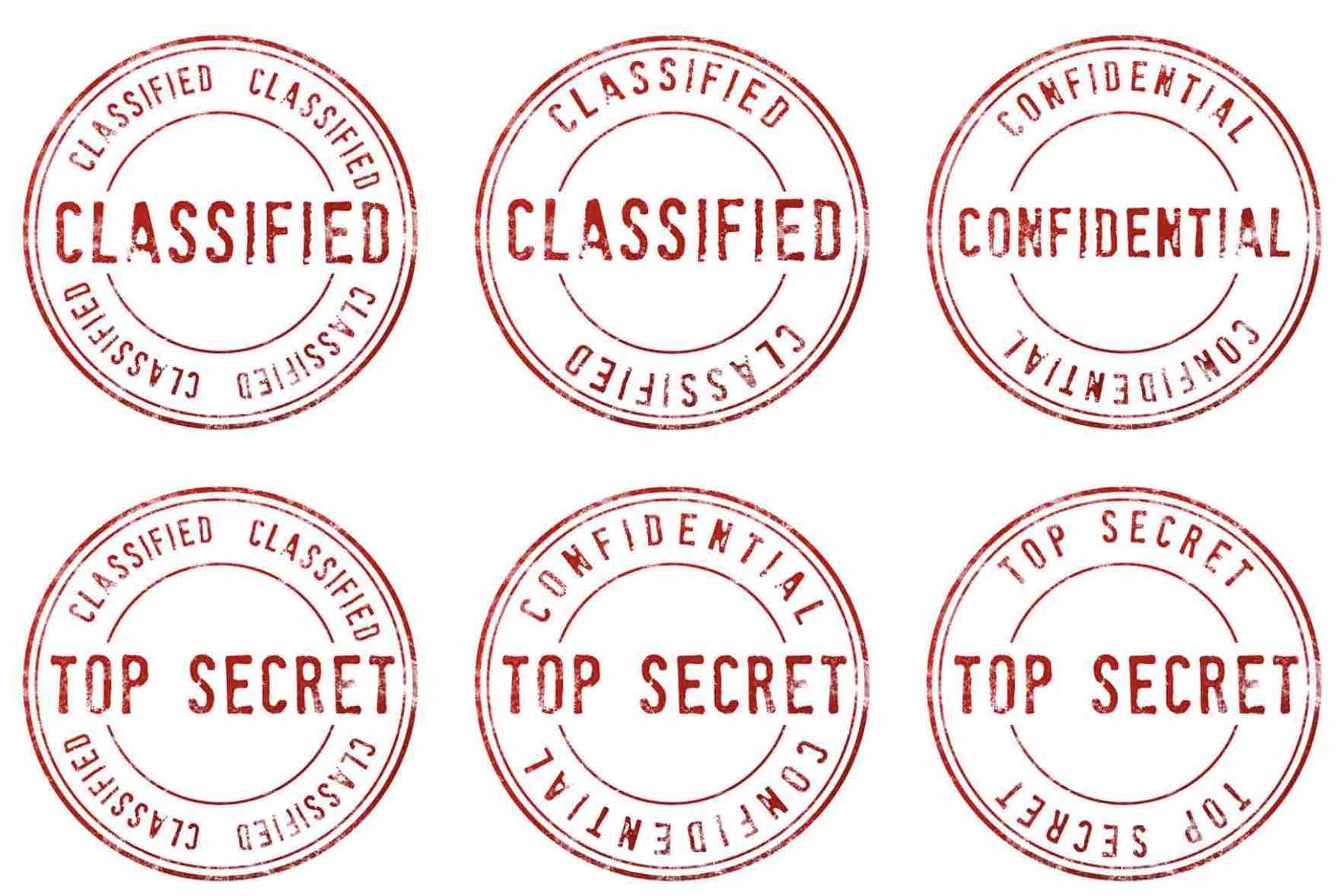
F. Trade Secret
1. What is a trade secret?
A trade secret is a piece of information that:
-
is not generally known to the public;
-
confers an economic benefit to its holder because the information is not publicly known; and
-
is the subject of reasonable efforts by the holder to maintain its secrecy.
Under international law, these three factors constitute a trade secret under article 39 of the Agreement on Trade-Related Aspects of Intellectual Property Rights, commonly referred to as the TRIPS Agreement.
In contrast to registered intellectual property, trade secrets are not disclosed to the world at large. Instead, owners of trade secrets seek to protect trade secret information from competitors by instituting special procedures for handling it, as well as technological and legal security measures.
Legal protections include non-disclosure agreements (NDAs), and work-for-hire and non-compete clauses (within the constraints of employment law, including only restraint that is reasonable in geographic- and time-scope), these protective contractual measures effectively create a perpetual monopoly on secret information that does not expire as would a patent or copyright.
2. What is the difference between trade secrets and patents?
Trade secrets inventions or creations are protected without the need for any registration or formality. A trade secret can also last for an unlimited period. It does not require one to expose the formula or manufacturing process of your invention and can, offer and maintain confidentiality.
Unlike a patent where you can sue an infringer, you cannot sue someone for using your trade secret. However, you can sue someone for inappropriately acquiring or leaking your trade secret. For instance, if Bill has a trade-secret neck massage method, he cannot sue Charles for using a similar massage method. Bill can only sue Charles if Charles improperly acquired the neck massage method (e.g. spying on Bill's massage process).
3. How can I protect my trade secrets?
The lack of formal protection associated with registered intellectual property rights, however, means that a third party not bound by a signed agreement is not prevented from independently duplicating and using the secret information once it is discovered, such as through reverse engineering.
The best way to protect your trade secrets is to keep your trade secrets in a secured location where it is not easily accessible by others. Coca-Cola is renowned for keeping its secret formula in a vault at the World of Coca-Cola in Atlanta. If you are keeping your trade secrets online, you should ensure that your server is secured to prevent hackers from stealing your information.
4. How long can I protect my trade secrets?
If you are disclosing your trade secrets to a third party, you should ensure that they sign a confidentiality agreement or a non-disclosure agreement ("NDA") before doing so. As to how long such confidentiality obligations would last is really a matter of contract. In theory, there is no time limit for trade secrets and they can last forever. As long as you can prove that the secret continues to have commercial value and bring you some economic benefits, and you have tried to keep this secret, it will always be kept as a trade secret.
G. Intellectual Property Agreements
To protect your intellectual property rights, DocPro has various forms of intellectual property documents to choose from:
1. Trade Secrets
One-way Non Disclosure Agreement for Discussion of Business Relationship - this imposes a unilateral obligation of confidentiality on the party who receives the information:
https://docpro.com/doc199/nda-confidentiality-agreement-for-business-one-way-unilateral-neutral
Two-way Non Disclosure agreement for Discussion of Business Relationship - this imposes a mutual obligation of confidentiality on the parties who provide and receive information at the same time:
https://docpro.com/doc202/nda-confidentiality-agreement-for-business-two-way-mutual-neutral
Three-way Non Disclosure agreement for discussion of Business Relationship - this imposes a mutual obligation of confidentiality on the parties who provide and receive information at the same time:
https://docpro.com/doc219/nda-confidentiality-agreement-for-business-three-way-mutual-neutral
2. Copyright
Copyright License Agreement - Copyright License Agreement whereby the Licensor grants the Licensee the right to use the copyright works for commercial production.
https://docpro.com/doc294/copyright-licence-agreement-neutral
Copyright License - Letter to Copyright user allowing the use or reproduction of copyrighted materials with attribution.
https://docpro.com/doc856/copyright-licence-copyright-reproduction-approval
Software License - Standard terms and conditions / End User Licence Agreement for software.
https://docpro.com/doc969/software-licence-terms-and-conditions
3. Patent
Patent / Technology License Agreement - the Licensor grants the Licensee a limited range of rights (no right to sub-license) to use the invention/patent works for specific purposes.
https://docpro.com/doc973/patent-technology-licence-agreement-neutral-limited-scope
Patent / Technology License Agreement - the Licensor grants the Licensee a wide range of rights (including the right to sub-license) to use the invention/patent works for commercial production.
https://docpro.com/doc970/patent-technology-licence-agreement-neutral-wide-scope
Patent Assignment Agreement - simple assignment of invention/patent from the assignor and the assignee
https://docpro.com/doc1277/assignment-agreement-patent
4. Trademark
Trademarks Licence Agreement - the Licensor grants the Licensee the right to use the trademarks for products, goods, or services.
https://docpro.com/doc299/trademark-licence-agreement-neutral
Trademark Assignment Agreement - a simple assignment of intellectual property between the assignor and the assignee.
https://docpro.com/doc967/assignment-agreement-intellectual-property
H. Conclusion
Hopefully, this article has given you a basic idea of what IP rights you want to obtain for your business. As promised, we have also prepared a handy guide for you to prepare documents for IP rights registration:
https://docpro.com/doc378/introduction-to-intellectual-property-guide
While the information above applies to most common law jurisdictions, you may wish to check with your local solicitor to see if any jurisdiction-specific rules uniquely apply in your locality.
I. Links to World Intellectual Property Organizations:
World Intellectual Property Organization (WIPO) has one of the most important and comprehensive databases on intellectual property rights which you can access here.
Each country also has its own intellectual property organization, below are links to some of the more popular jurisdictions:
| Country |
Web Links |
|
Australia |
https://www.ipaustralia.gov.au/ |
|
Canada |
https://www.ic.gc.ca/ |
|
United States |
|
|
United Kingdom |
https://www.gov.uk/government/organisations/intellectual-property-office |
|
Hong Kong |
https://www.ipd.gov.hk/eng/home.htm |
|
India |
https://ipindiaonline.gov.in/ |
|
South Korea |
|
|
Singapore |
https://www.ipos.gov.sg/ |
|
Japan |
|
|
New Zealand |
https://www.iponz.govt.nz/ |
|
Pakistan |
http://www.ipo.gov.pk/ |
|
South Africa |
http://www.cipc.co.za/ |
Please note that this is just a general summary of the position under common law and does not constitute legal advice. As the laws of each jurisdiction may be different, you may want to speak to your legal advisor.
Keywords:

